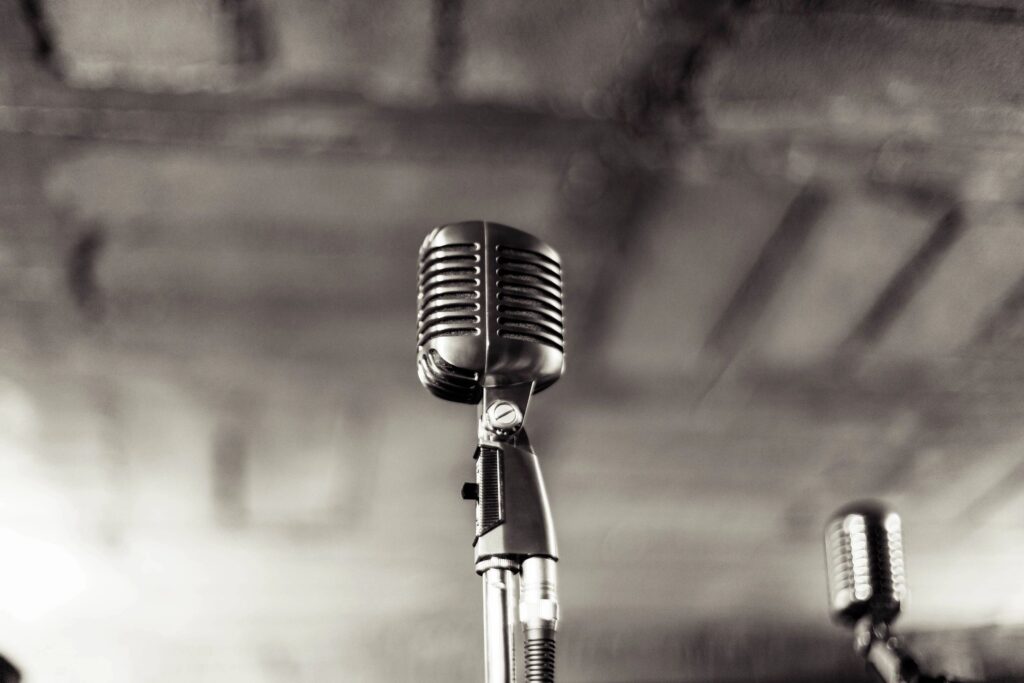RECOMMENDED VIDEO COURSE:
Speak Up! Public Speaking for Leadership Development
Microphone Tips for Presenters and Speakers
It’s not natural to speak into a microphone. So using it properly will take some practice. Keep these tips in mind.
It may seem inconvenient to remember all these things, but remember that your microphone is your voice.
Poor use of the microphone means your voice will get lost, or the audience will have a hard time hearing you.
If they can’t hear you, then they can’t receive your message. It’s that simple.
I’ve seen many otherwise great speakers use microphones incorrectly and their impact suffers massively as a result. I’ve made these mistakes myself as well.

1. Don’t Hide Your Face with the Microphone
For stationary mics attached to a podium or table, move it down so that it’s not blocking your face.
This is especially important for short people standing behind a podium.
Facial expressions are a major part of communication, so you need your face to be clearly visible to the crowd.
For hand-held microphones, position the mic so that your whole face is clearly visible. Hold it vertically so that it only blocks your chin.
Singers and rappers hold their microphone pointing straight out, which blocks the lower half of their face:


But for public speaking and presentations, you want to hold the microphone lower, so that your mouth is visible:



2. Hold it Very Close to Your Mouth – Closer than You Think
This is one of the critical microphone tips. It affects how loud your voice will sound.
Each microphone has different settings (which can be adjusted by the sound crew).
But as a general rule, it’s better for your voice to be on the louder side than the quieter side.
Watch the following clip, starting at 11:30.
Notice the huge difference in volume between the moderator (the guy who is talking at 11:30) and the woman with the red scarf.
If you look, you will see that the moderator is holding the microphone in his lap, far away from his face. Whereas the woman in the red scarf holds it right in front of her mouth.
3. Keep Your Microphone Arm Completely Stationary
People inexperienced with microphones will often move their arms around as they talk, as if they were not holding it at all.
Obviously this is a mistake because your voice will keep fading in and out. The audience will have an extremely hard time understanding you.
This is another one of those habits that is easy to overlook, but which has a huge impact on your speech.
4. Test the Mic Before Your Speech Begins
You should never have to ask “can everyone hear me ok?”
You should already know that the mic is working long before you take the stage and begin speaking.
Arrive early and test it out so you can just hit the ground running when you open your speech.
If you will be turning your mic on and off throughout your presentation (for example, in a workshop), make sure you can do that without making it screech and hurting everyone’s ears.
5. Podium Microphones: Position the Mic So You Don’t Have to Slouch
Newbies have an urge to lean into podium microphones. This gives you bad posture and obscures your face to the audience.
Unlike with handheld mics, a podium mic should be sensitive enough to pick up your voice even when you are standing up straight.
Finally, two tips on wearable microphones:
6. Don’t Wear Jewelry That Will Bang Against the Mic
This is extremely annoying and distracting for the audience.
And it’s the kind of thing that is so minor, and so easy to overlook, but really interferes with the audience’s retention of your message.
Watch the following interview. Olivia, the guest in the pink dress, has a microphone on her collar.
Her necklace got tangled up with the microphone. You can hear an audible clicking and snapping as she speaks and moves throughout the interview:
This is really an error by the production crew. They should have clipped the mic on properly.
But Olivia, the guest, is the one who suffers.
This is one of those simple microphone tips that is easy to forget.
7. Avoid Long Hair Brushing Against the Mic
The same thing can happen with long hair.
Watch Sheryl Sandberg’s TED talk from 2010 below. In the first few minutes, she is wearing a headset mic which keeps getting interference either from her hair or because it’s been placed too close to her face. So a member of the crew has to give her a handheld mic at 4:15:
Remember: although the technical crew manages your microphone and audio, you’re the speaker. You’re the one in the spotlight.
So ultimately the audience will associate any audio problems with you and your speech. Rightly or wrongly, that’s just how their perception is.
Check and double-check your microphone beforehand.
RECOMMENDED VIDEO COURSE:
Speak Up! Public Speaking for Leadership Development
- You Are Who You Surround Yourself With: 6 Tactics to Build Your Network - December 15, 2021
- Executive Presence: 3 Keys to Communicate Leadership Qualities - December 10, 2021
- How to Think on Your Feet in Meetings and Presentations: 3 Mental Hacks - February 13, 2021

